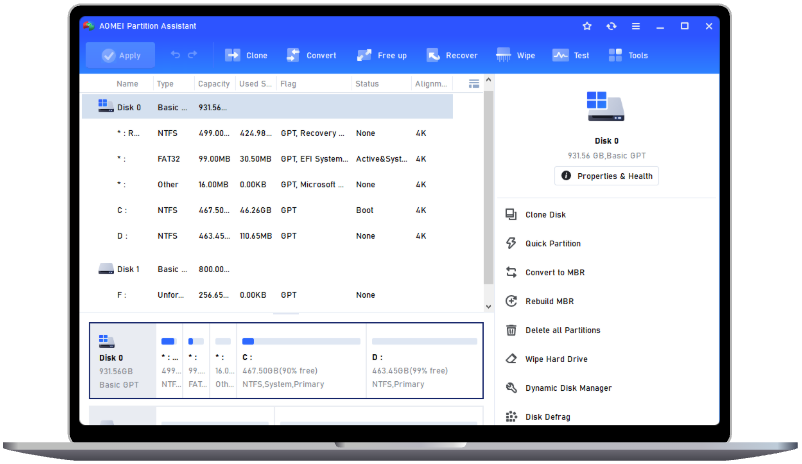5 Easy Ways to Change Lock Screen Password Windows 10
People may change lock screen password Windows 10 for various reasons. In this guide, you will learn five different yet powerful methods to perform Windows lock screen password change easily and quickly.
Why need change lock screen password in Windows 10/11?
Changing your lock screen password in Windows 10/11 is a simple yet effective way to improve your security. Whether you’re protecting personal or work-related data, regularly updating your password ensures that your system remains safe from unauthorized access. Here are some key reasons why you should update your password regularly:
1. Enhance security against unauthorized access
Regularly updating your lock screen password helps prevent unauthorized access to your system. This is especially crucial if you store sensitive information on your computer.
2. Protect against data breaches
If your current password has been compromised or leaked online, changing it immediately helps protect your personal data from potential cyber threats.
One of the most common reasons for changing a lock screen password is forgetting the current one. If you can't remember your password, you may need to reset it using a recovery method.
4. Prevent unauthorized physical access
If you frequently use your laptop in public places or share a workspace, changing your lock screen password periodically ensures that no one else can gain access without permission.
5. Maintain privacy for personal files and documents
Your lock screen password is the first line of defense against anyone trying to access your personal files, emails, or confidential work documents.
How to change lock screen password Windows 10/11
Changing your lock screen password in Windows 10 is essential for maintaining security. Fortunately, there are multiple ways to update your password, whether you remember your current one or need to reset a forgotten password. Below, we’ll walk you through five effective methods step by step.
Method 1. Change lock screen password via Windows settings
The most straightforward way to change your lock screen password is through Windows Settings. This method is ideal for those who prefer a graphical interface.
Step 1. Open the Windows Settings, then click the "Accounts" option.
Step 2. Click "Sign-in options" tab and click "Change" under the "Password" section.
Step 3. In the new window, input the current password and click "Next".
Step 4. Input the new passwords and click "Next".
Method 2. Change password using Ctrl + Alt + Delete
The Ctrl + Alt + Delete method provides a quick way to change your password without navigating through multiple settings. It is useful when you are already logged in and need to update your password efficiently.
Step 1. When logging into the system with the current password, press the "Ctrl + Alt + Del" keys at the same time.
Step 2. Select "Change a password" on the new screen.
Step 3. Enter your old password, leave the "Current password" and "Confirm password" boxes empty, and press "Enter".
Step 4. Then, every time when you log in, you can get in without typing the password.
Method 3. Change lock screen password via Command Prompt
For advanced users, using CMD to change password offers a quick way to make it. This method is particularly useful when managing multiple accounts or when the graphical interface is not working properly.
Step 1. Open the Start menu, type cmd, and right-click on Command Prompt to select Run as Administrator.
Step 2. Use the following command to reset a local administrator password:
net user username newpassword
For example:
net user admin 123456
Step 3. Alternatively, you can create a new administrator account with these commands:
- net user newusername /add
- net localgroup administrators newusername /add
Method 4. Change lock screen password via Control Panel
The Control Panel provides another traditional way to change your password. This method is useful for users who are accustomed to older Windows interfaces.
Step 1. Press “Win+X” and find the“Control Panel”(or type “Control Panel” in the search box).
Step 2. Select “User Accounts” and find “Manage another account”
Step 3. Choose “Manage another account” and then select the account you hope to remove its password.
Step 4. Leave the blank in the password confirmation. Directly select “Change password” as the picture shows. And now you remove the account password successfully.
Method 5. Resetting a forgotten password
If you have forgotten your password, you won’t be able to log in. However, Windows provides several ways to reset it, depending on whether you use a Microsoft account or a local account. If you are using a Microsoft account, you can directly go to the Microsoft website and reset the password.
However, if you are a local account user, it requires a password reset disk created before forgetting the password. If not, AOMEI Partition Assistant offers a powerful solution to reset it easily. This all-in-one disk management software includes a "ResetWindows Password" feature that allows you to make a password reset USB even after forgetting and then boot from the USB to regain access to your system without reinstalling Windows or losing data.
Step 1. Download and install AOMEI Partition Assistant on a functioning Windows computer. Connect a USB drive to this computer. Launch the AOMEI software and navigate to "Tools" and "Reset Windows Password" on the main interface.
Step 2. Click "Next" to confirm creating a WinPE bootable media.
Step 3. Select the target USB drive and click "Proceed".
Step 4. Note that the USB drive will be formatted during the process. If you have backed up essential data or there is no critical information on it, click "Yes" to proceed.
Step 5. Insert the password reset USB into the Windows computer that requires password resetting. Adjust the boot order in the computer's BIOS to prioritize booting from the USB drive.
Step 6. Once the computer boots from the USB, this tool will launch automatically. Click "Reset Password" and select the target operating system. Then, click "Next".
Step 7. Choose the account for which you want to reset the password and decide whether you want to remove or reset the account password. Select "Reset Account Password" and click "Next".
Step 8. In the "Reset Password" window, enter the new password and click "Yes" to confirm the changes.
Conclusion
There are multiple ways to change lock screen password in Windows 10/11, which is crucial for maintaining security and protecting sensitive data. If you forget your password, you can reset it using Microsoft’s recovery options or a password reset disk. For local account users without a reset disk, AOMEI Partition Assistant offers a simple way to regain access through its "Reset Windows Password" feature, allowing you to create a bootable USB and unlock your system without reinstalling Windows.


